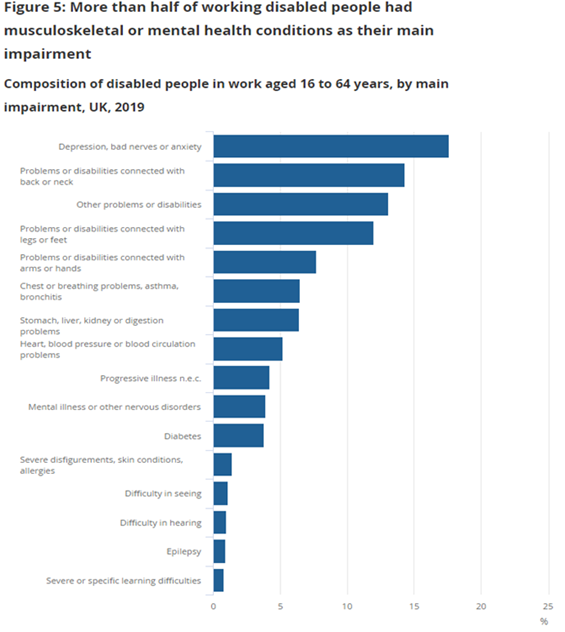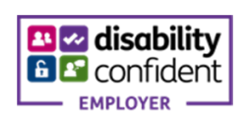Disability in the workplace (Disability)
As part of our Diversity and Inclusion awareness feature, in March we looked at women in the workplace. In April, we shift our focus to look at improving employment opportunities for people with disabilities, which is topical in the light of events this month including World Autism Awareness Day (2nd April), Autism Together Awareness Month (raising awareness and acceptance of autism) and World Health Day (7th April). World Health Day focuses on a specific health topic of concern to people all over the world and this year’s topic is Our Planet, Our Health. The World Health Organisation (WHO) estimates that more than 13 million deaths around the world each year are due to avoidable environmental causes (World Health Day 2022).
The disability definition is contained in the Equality Act 2010, a person is ‘disabled’ if they have a physical or mental impairment which has a substantial and long-term adverse effect on their ability to carry out normal day-to-day activities. In the UK, around seven million people of working age with a disability or long-term health condition, yet only about half of them are in work (Disability & Employment | Factsheets | CIPD). Considering the difficulties faced by all employers in a recruitment market where skills and candidates are in short supply, employers are increasingly keen to reach out to under-represented groups, including people with both physical and mental disabilities. According to the Recruitment a
nd Employment Confederation (REC), recruitment professionals have a key role to play in making change happen and the government’s Disability Confident Scheme helps employers make the most of the opportunities provided by employing disabled people (Disability Confident Scheme Reaches 2 Years - REC).

In their report on Disability and employment in the UK, the Office of National Statistics (ONS) found that between 2013 and 2019, the disability employment gap reduced; with the latest data showing roughly half of disabled people were in employment (53.2%) compared with just over four out of five non-disabled people (81.8%) based on the Labour Force Survey results (Disability and employment, ONS). When looking at only disabled people in work in 2019, more than a third cited their main impairment as a condition affecting the musculoskeletal system and more than one in five working disabled people cited a mental health condition as the main cause of their disability, consisting of depression, bad nerves or anxiety, mental illness or other nervous disorders. As seen in the below figure produced by ONS, depression, bad nerves or anxiety was the single most common type of impairment mentioned (Disability and employment, UK - Office for National Statistics).

Considering these figures, it is relevant now more than ever for businesses to make changes in their approach to ensure the organisation and the services they provide are accessible to disabled people as well as everybody else. Such alterations are known as reasonable adjustments and can apply to the physical building as well as policies, procedures and training.
Reasonable adjustments
The aim of a reasonable adjustment is to allow a person with a disability to carry out their work in a way that does not put them at a disadvantage with their colleagues. In line with information provided by the Chartered Institute of Personel Development (CIPD) and Advisory, Conciliation and Arbitrary Service (Acas), examples of reasonable adjustments vary person to person, but could include:
- Altering premises – such as automated doors, providing ramps, quiet spaces, alternative formats of signage or directions around the building.
- Altering assessment procedures – such as giving extra time, providing assistive technology or ergonomic equipment.
- Training or mentoring – such as supporting an employee to use new adjustments (such as speech to text software), or coping strategies (common with, for example, dyslexia or mental health conditions).
- Modified or specialist equipment – such as supportive chairs, height-adjustable or standing desks.
- Communication – such as providing an interpreter (for people who are, for example, deaf or who have a speech impairment).
- Time off during working hours – for example, for hospital appointments, physiotherapy, counselling, or treatment.
- Phased return to work – for example, for an employee who’s been on long-term sick leave because of their disability.
- Flexible working or adjusted hours – to help employees find a work life balance and fit around their support needs.
- Offering more one-to-one support – to help prioritise the work of an employee suffering from anxiety.
- Promoting an Employee Assistance Programme (EAP) – a confidential service to support staff with personal or workplace issues that might be impacting their performance, wellbeing, mental or physical health.
- Flexible working – for disabled workers, especially post pandemic working arrangements, to continue to access flexible working as a reasonable adjustment.

Taking action to support your disability inclusion journey
By becoming a Disability Confident Employer and seeking guidance from organisations like the Recruitment Industry Disability Initiative (RIDI) and signing up for the RIDI awards (progressing through 3 levels), businesses can gain the tools and expertise they need to successfully tap into this valuable, but underused, talent pool and enhance their reputation for being an inclusive employer.
- Join the Recruitment Industry Disability Initiative (RIDI) – use the Clear Kit online toolkit and the Clear Assured self-assessment framework to identify and remove the barriers in your recruitment. Use the Disability Inclusion calculator on their website to measure and calculate your disability employment gap (Ridi).
- Sign up to the Disability Confident Scheme – developed by employers and disabled people’s representatives, it provides free access to guidance, good practice and resources. It aims to help employers draw from the widest possible pool of talent, secure high quality staff who are skilled, loyal and hardworking and improve employee morale and commitment by demonstrating all employees are treated fairly (Disability Confident - dwp.gov.uk).
- Review recruitment methods – consider advertising jobs on websites and in publications designed for disabled people and make the adverts accessible, e.g. use text that a screen reader can understand instead of an image with text embedded into it, and use a large font in print adverts. Consider publicising your job advert with the ‘two ticks’ scheme, which guarantees that disabled people who meet the minimum criteria will get an interview. Consider including a reasonable adjustment statement by offering documents in a more accessible format i.e. candidate briefs, as part of your process.
- Build awareness and confidence through training– to ensure staff, especially line managers, understand their legal obligations. Managers need to know how to navigate conversations about disability and conditions with employees and implement reasonable adjustments. CIPD and the DWP Disability Confident Scheme published a practical guide to recruiting, managing and developing people with a disability or health condition (Disability Confident and CIPD: guide for line managers - GOV.UK).
- Make reasonable adjustments – allow disabled people to have the same access to the workplace as their non-disabled colleagues. Consult with Occupational health advisors. This includes being prepared to make reasonable adjustments for candidates who get an interview as part of the recruitments process, to enable them to attend.
- Maintain a balance – to support disabled employees who continue to work from home (post pandemic) or adopt a hybrid working arrangement, it is important to maintain a flexible approach concerning hours, location and making the necessary adjustments at home or office to enable staff to work safely and effectively.
- Seek further guidance and expertise through Acas advice hub– to ensure employees with disabilities get the best support at work (Disability at work | Acas).
Everyone should have the opportunity to demonstrate their full set of skill and abilities. Businesses must continue to become more inclusive to disabled talent and create barrier-free inclusive workplaces where people with disabilities can progress and thrive at work.
Lizzy Turek
Client Research Associate


